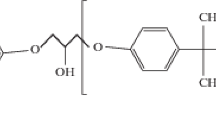Abstract
The intrinsic properties of nanofillers and the properties of the filler-matrix interface layer are key factors affecting the electrical properties of epoxy composites. Functional modification of nanofillers can effectively regulate the interfacial interaction between the filler and the matrix, improve the modification effect of nanofillers on epoxy composites, and then achieve electrical properties such as dielectric, conductivity, and charge transport of epoxy composites. This chapter takes coupling agent modification, fluorination modification, and amination modification as examples to introduce the methods of functional modification of nanofillers, and studies the influence of functionalized nanofillers on the electrical properties of epoxy composites. The mechanism of filler functional modification to improve the insulation performance of epoxy composites was analyzed by combining microscopic characterization and molecular simulation. It provides new ideas and methods to improve the electrical properties of epoxy composites and expand the application of nano-modification technology in the field of insulating materials.
Access this chapter
Tax calculation will be finalised at checkout
Purchases are for personal use only
Similar content being viewed by others
References
Li, S., Li, J.Y.: Condition monitoring and diagnosis of power equipment: review and prospective. High Volt. 02(02), 82–91 (2017)
Yang, S., **ang, D., et al.: Condition monitoring for device reliability in power electronic converters: a review. IEEE Trans. Power Electron. (2010)
Fan, B.H., Zha, J.W., Wang, D., et al.: Size-dependent low-frequency dielectric properties in the BaTiO3/poly (vinylidene fluoride) nanocomposite films. Appl. Phys. Lett. 100(1), 012903 (2012)
Zha, J.W., Dang, Z.M., Li, W.K., et al.: Effect of micro-Si3N4-nano-Al2O3 co-filled particles on thermal conductivity, dielectric and mechanical properties of silicone rubber composites. IEEE Trans. Dielectr. Electr. Insul. 21(4), 1989–1996 (2014)
Landry, C., Coltrain, B.K., Landry, M.R., et al.: Poly(vinyl acetate)/silica-filled materials: material properties of in situ vs fumed silica particles. Macromolecules 26(14), 3702–3712 (1993)
Giannelis, E.P.: Polymer layered silicate nanocomposites. Adv. Mater. 8(1), 1–9 (1996)
Lewis, T.J.: Interfaces: nanometric dielectrics. J. Phys. D Appl. Phys. 38(2), 202 (2005)
Tanaka, T., Kozako, M., Fuse, N., et al.: Proposal of a multi-core model for polymer nanocomposite dielectrics. IEEE Trans. Dielectr. Electr. Insul. 12(4), 669–681 (2005)
Heid, T., Fréchette, M., David, E.: Enhanced electrical and thermal performances of nanostructured epoxy/POSS composites. IEEE Trans. Dielectr. Electr. Insul. 23(3), 1732–1742 (2016)
Valentini, L., Puglia, D., Carniato, F., et al.: Use of plasma fluorinated single-walled carbon nanotubes for the preparation of nanocomposites with epoxy matrix. Compos. Sci. Technol. 68(3–4), 1008–1014 (2008)
Yin, Z., Sun, P., Sima, W., et al.: Synergistic enhancement of arc ablation resistance and mechanical properties of epoxy resin insulation. IEEE Trans. Dielectr. Electr. Insul. 27(3), 748–756 (2020)
Jiyuan, Y.A.N., Liang, G., Hongliang, L., et al.: Effect of plasma step gradient modification on surface electrical properties of epoxy resin. Plasma Sci. Technol 23(6), 064012 (2021)
Lei, W., Mochalin, V., Liu, D., et al.: Boron nitride colloidal solutions, ultralight aerogels and freestanding membranes through one-step exfoliation and functionalization. Nat. Commun. 6, 8849 (2015)
Simmons, J., Tam, M.: Theory of isothermal currents and the direct determination of trap parameters in semiconductors and insulators containing arbitrary trap distributions. Phys. Rev. B 7(8), 3706–3713 (1973)
Lv, F.C., Yin, K., Fu, K.X., et al.: Effect of fluorination and exfoliation filler on the surface flashover voltage of boron nitride/epoxy resin composites. High Volt. Eng. 43(9), 8 (2017)
**e, Q., Zhang, Y.J., Duan, Q.J., et al.: Effect of fluorinated modified graphene nanoplatelets on surface voltage resistance properties of epoxy resin composites. Proc. CSEE
Wang, Y.N., Lu, X., Yan, L.D., et al.: Effect of amino modified boron nitride nanosheets on surface insulation properties of epoxy resin. Insul. Mater. 54(09), 48–54 (2021)
Zhang, S., Chen, W., Zhao, Y., et al.: Surface NH2-functionalized by C do** of boron nitride nanotube to improve the thermal conductivity of epoxy composites. Compos. B Eng. 223, 109106 (2021)
Li, J., Liang, H., **ao, M., et al.: Mechanism of deep trap sites in epoxy/graphene nanocomposite using quantum chemical calculation. IEEE Trans. Dielectr. Electr. Insul. 26(5), 1577–1580 (2019)
Author information
Authors and Affiliations
Corresponding author
Editor information
Editors and Affiliations
Rights and permissions
Copyright information
© 2024 The Author(s), under exclusive license to Springer Nature Singapore Pte Ltd.
About this chapter
Cite this chapter
Ruan, H., **e, Q., Duan, Q., **e, J. (2024). Regulation Method and Mechanism of Functionalized Modified Nano Filler on Electrical Properties of Epoxy Resin. In: **e, Q. (eds) Electrical Materials. Engineering Materials. Springer, Singapore. https://doi.org/10.1007/978-981-99-9050-4_4
Download citation
DOI: https://doi.org/10.1007/978-981-99-9050-4_4
Published:
Publisher Name: Springer, Singapore
Print ISBN: 978-981-99-9049-8
Online ISBN: 978-981-99-9050-4
eBook Packages: Physics and AstronomyPhysics and Astronomy (R0)




